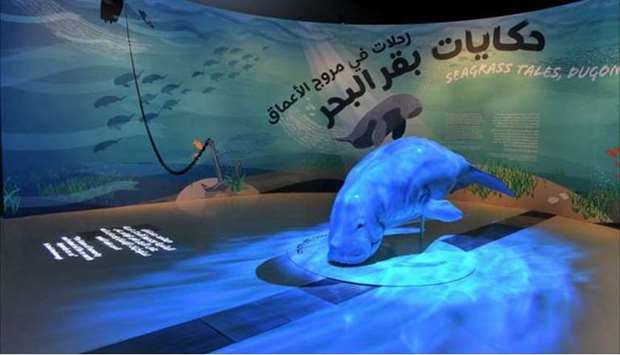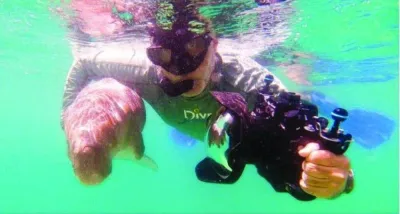“Seagrass Tales, Dugong Trails” examines the animal’s habits, habitat and ongoing cultural significance for Qatar
The National Museum of Qatar (NMoQ) unveiled on Tuesday (June 15) Seagrass Tales, Dugong Trails, a special exhibition on the dugong (baqarat albahr), the shy marine mammal that has inhabited the waters surrounding the peninsula for more than 7,500 years.
The exhibition will examine the animal, its environment and its ongoing cultural significance for Qatar, while highlighting how the community can mitigate the dugong’s threat of extinction.
Seagrass Tales, Dugong Trails is presented in collaboration with ExxonMobil Research Qatar (EMRQ) with the help of researchers and scientists at Texas A&M University at Galveston and Qatar University (QU) and the support of the Ministry of Municipality and Environment (MME) and Unesco Doha Office.
“The dugong is a fascinating creature, and its story is sure to captivate museum visitors of all ages,” NMoQ director Sheikha Amna bint Abdulaziz bin Jassim al-Thani said in a statement.
“We want to inform our public about the importance of protecting these mammals, which have special cultural and environmental significance to the people of Qatar. With this in mind, the National Museum has adopted the dugong as its official mascot. We are thankful to our many partners who supported the research behind Seagrass Tales, Dugong Trails, especially ExxonMobil Research Qatar,” she added.
Since 2014, ExxonMobil Research Qatar, Texas A& M Galveston and QU have collaborated to develop research on the dugong in Qatar to protect their natural habitat.
In 2018, ExxonMobil Research Qatar launched a campaign to raise environmental awareness to protect the dugong.
“We’re delighted that NMoQ is hosting Seagrass Tales, Dugong Trails – this exhibition is important in supporting the research work and conservation efforts we have been doing at our center to help protect Qatar’s dugong population,” said Nayla al-Naema, senior environmental scientist for ExxonMobil Research Qatar. “I’m incredibly passionate about this gentle creature we’re privileged to have in our waters and it’s wonderful to see it being portrayed in its natural habitat so remarkably – we’re grateful for the museum’s partnership and support.”
The exhibition takes the name Seagrass Tales, Dugong Trails from the trails that the animal leaves as it travels through seagrass meadows, an important element of the underwater ecosystem.
Eating all day and all night, dugongs use their heavy bones to sink down to the seafloor and their bristly snouts to detect plants and sweep them into their mouths.
The exhibition is organised into three overarching themes – learning, discovery, and experience – and is curated by Evangelia Patmali, an exhibition researcher, and Bouthayna M Baltaji, Head of Exhibitions at NMoQ.
Visitors will be introduced to the dugong – a sirenian (or “sea cow”) closely related to the manatee, and the last living species in the Dugongidae family – and invited to learn about its physiology and anatomy, scientific classification and evolution, and history in the region.
Dugongs typically measure more than 3m in length and can weigh up to 550kg. They date back 50mn years, to the Tethys Sea region.
While dugongs typically live alone or in small groups, travelling along the coast and grazing on up to 40kg (10% of their mass) of seagrass per day, the largest herds in the world, comprising approximately 800 dugongs coming together to breed, have been recorded in Qatar.
The exhibition will also highlight how the dugong has long held significance to the people of Qatar. Historically, dugong hide was used for sandals, their tusks for Sheikh’s swords, and their oil and fat for cooking, medicine, potions, and to coat wooden boats.
For decades, the animal has inspired indigenous communities to make art and engage in scientific study. The dugong live in three main areas in the Gulf: the coastal area in the UAE near Murawah Island, the northwest coast of Qatar from the Zekreet peninsula and the Hawar Islands to Ras Ushayriq and offshore to Fasht Adhm, Bahrain, and the coastal region of Saudi Arabia between the UAE and Qatar.
Although dugongs are protected under the Qatar MME and the International Union for Conservation of Nature, localised fishing, pollution, and coastal development have contributed to environmental degradation that threatens the animal’s extinction.
The exhibition will conclude by sharing how visitors can help protect the dugong in Qatar, as well as highlighting different professions in research and conservation (marine biologists, chemists, geologists, palaeontologists, ecologists, zoologists, ethologists, etc.) that are helping to maintain the dugong’s natural habitat.
Throughout the exhibition, visitors will have the opportunity to engage in experiential activities, offered within NMoQ’s comprehensive protocols for preventing Covid-19.
The unique experiential environments of Seagrass Tales, Dugong Trails will include a simulated underwater habitat and a laboratory. An exhibition highlight includes the installation of a dugong skeleton dating from 2012.
The remarkable skeleton was recently added to the permanent collection of the National Museum, having been donated by a family from Al Khor city.
Additional exhibition highlights include a presentation of the flora and fauna found in dugong habitats, including the few species of seagrass that can tolerate the high salt levels and extreme temperature variations of the Gulf, as well as green sea turtles, snapping shrimp, Arabian carpetsharks, goatfish, and blue swimming crabs.
The exhibition will also detail the history of dugong research in Qatar, displaying a timeline of the first discoveries and excavations to the construction of the first full skeleton. An infant dugong, discovered by Dr Mehsin al-Ansi from QU with Ismail al-Shaikh from EMRQ, will also be on view in the entrance to the NMoQ school lobby.
The baby dugong taxidermy and skeleton will be on display alongside a film screening that explains the last days before its passing. The baby dugong died due to being separated from its mother – most likely due to a vessel strike or bycatch accident.
The film aims to serve as an important reminder for the wider community to protect and preserve local marine life.
The dugong was selected as NMoQ’s mascot based on its representation of the museum’s ethos of sustainability and environmental awareness, and also for its cultural significance as part of Qatar’s local heritage.
Last year, in celebration of the museum’s first anniversary, local and international artists, designers, and creatives were invited to design a dugong mascot for the NMoQ.
In October 2020, NMoQ announced Gaylord “Choy” Salonga, a graphic designer from the Philippines, as the winner of its Dugong Mascot Design competition.
Seagrass Tales, Dugong Trails will remain on view through July 15 and is presented as part of the Qatar – USA 2021 Year of Culture, which was formalised in September 2020 with a cooperative agreement between the State of Qatar and USA during the 2020 Qatar – US Dialogue in Washington, DC.
In keeping with the guidelines set by the Ministry of Public Health, a limited number of visitors and staff will be allowed inside each museum. Visitors will be required to reserve tickets in advance on the Qatar Museums website: https://visit.qm.org.qa/.
Upon arrival at the museum, ticketholders must present a “green” health status on the Ehteraz app. Each person will also be checked for a normal temperature reading at the entrance. Visitors, who are 12 years of age and above, will be required to bring and wear a mask.
Hand sanitiser stations will be placed throughout the location encouraging visitors to keep their hands clean. Signage reminding visitors to keep a safe distance from other visitors will also be visible on site.
In addition, interactive features at each museum such as touchscreens will be temporarily removed, and gallery guides will be offered online only.
The exhibition will examine the animal, its environment and its ongoing cultural significance for Qatar, while highlighting how the community can mitigate the dugong’s threat of extinction.
Seagrass Tales, Dugong Trails is presented in collaboration with ExxonMobil Research Qatar (EMRQ) with the help of researchers and scientists at Texas A&M University at Galveston and Qatar University (QU) and the support of the Ministry of Municipality and Environment (MME) and Unesco Doha Office.
“The dugong is a fascinating creature, and its story is sure to captivate museum visitors of all ages,” NMoQ director Sheikha Amna bint Abdulaziz bin Jassim al-Thani said in a statement.
“We want to inform our public about the importance of protecting these mammals, which have special cultural and environmental significance to the people of Qatar. With this in mind, the National Museum has adopted the dugong as its official mascot. We are thankful to our many partners who supported the research behind Seagrass Tales, Dugong Trails, especially ExxonMobil Research Qatar,” she added.
Since 2014, ExxonMobil Research Qatar, Texas A& M Galveston and QU have collaborated to develop research on the dugong in Qatar to protect their natural habitat.
In 2018, ExxonMobil Research Qatar launched a campaign to raise environmental awareness to protect the dugong.
“We’re delighted that NMoQ is hosting Seagrass Tales, Dugong Trails – this exhibition is important in supporting the research work and conservation efforts we have been doing at our center to help protect Qatar’s dugong population,” said Nayla al-Naema, senior environmental scientist for ExxonMobil Research Qatar. “I’m incredibly passionate about this gentle creature we’re privileged to have in our waters and it’s wonderful to see it being portrayed in its natural habitat so remarkably – we’re grateful for the museum’s partnership and support.”
The exhibition takes the name Seagrass Tales, Dugong Trails from the trails that the animal leaves as it travels through seagrass meadows, an important element of the underwater ecosystem.
Eating all day and all night, dugongs use their heavy bones to sink down to the seafloor and their bristly snouts to detect plants and sweep them into their mouths.
The exhibition is organised into three overarching themes – learning, discovery, and experience – and is curated by Evangelia Patmali, an exhibition researcher, and Bouthayna M Baltaji, Head of Exhibitions at NMoQ.
Visitors will be introduced to the dugong – a sirenian (or “sea cow”) closely related to the manatee, and the last living species in the Dugongidae family – and invited to learn about its physiology and anatomy, scientific classification and evolution, and history in the region.
Dugongs typically measure more than 3m in length and can weigh up to 550kg. They date back 50mn years, to the Tethys Sea region.
While dugongs typically live alone or in small groups, travelling along the coast and grazing on up to 40kg (10% of their mass) of seagrass per day, the largest herds in the world, comprising approximately 800 dugongs coming together to breed, have been recorded in Qatar.
The exhibition will also highlight how the dugong has long held significance to the people of Qatar. Historically, dugong hide was used for sandals, their tusks for Sheikh’s swords, and their oil and fat for cooking, medicine, potions, and to coat wooden boats.
For decades, the animal has inspired indigenous communities to make art and engage in scientific study. The dugong live in three main areas in the Gulf: the coastal area in the UAE near Murawah Island, the northwest coast of Qatar from the Zekreet peninsula and the Hawar Islands to Ras Ushayriq and offshore to Fasht Adhm, Bahrain, and the coastal region of Saudi Arabia between the UAE and Qatar.
Although dugongs are protected under the Qatar MME and the International Union for Conservation of Nature, localised fishing, pollution, and coastal development have contributed to environmental degradation that threatens the animal’s extinction.
The exhibition will conclude by sharing how visitors can help protect the dugong in Qatar, as well as highlighting different professions in research and conservation (marine biologists, chemists, geologists, palaeontologists, ecologists, zoologists, ethologists, etc.) that are helping to maintain the dugong’s natural habitat.
Throughout the exhibition, visitors will have the opportunity to engage in experiential activities, offered within NMoQ’s comprehensive protocols for preventing Covid-19.
The unique experiential environments of Seagrass Tales, Dugong Trails will include a simulated underwater habitat and a laboratory. An exhibition highlight includes the installation of a dugong skeleton dating from 2012.
The remarkable skeleton was recently added to the permanent collection of the National Museum, having been donated by a family from Al Khor city.
Additional exhibition highlights include a presentation of the flora and fauna found in dugong habitats, including the few species of seagrass that can tolerate the high salt levels and extreme temperature variations of the Gulf, as well as green sea turtles, snapping shrimp, Arabian carpetsharks, goatfish, and blue swimming crabs.
The exhibition will also detail the history of dugong research in Qatar, displaying a timeline of the first discoveries and excavations to the construction of the first full skeleton. An infant dugong, discovered by Dr Mehsin al-Ansi from QU with Ismail al-Shaikh from EMRQ, will also be on view in the entrance to the NMoQ school lobby.
The baby dugong taxidermy and skeleton will be on display alongside a film screening that explains the last days before its passing. The baby dugong died due to being separated from its mother – most likely due to a vessel strike or bycatch accident.
The film aims to serve as an important reminder for the wider community to protect and preserve local marine life.
The dugong was selected as NMoQ’s mascot based on its representation of the museum’s ethos of sustainability and environmental awareness, and also for its cultural significance as part of Qatar’s local heritage.
Last year, in celebration of the museum’s first anniversary, local and international artists, designers, and creatives were invited to design a dugong mascot for the NMoQ.
In October 2020, NMoQ announced Gaylord “Choy” Salonga, a graphic designer from the Philippines, as the winner of its Dugong Mascot Design competition.
Seagrass Tales, Dugong Trails will remain on view through July 15 and is presented as part of the Qatar – USA 2021 Year of Culture, which was formalised in September 2020 with a cooperative agreement between the State of Qatar and USA during the 2020 Qatar – US Dialogue in Washington, DC.
In keeping with the guidelines set by the Ministry of Public Health, a limited number of visitors and staff will be allowed inside each museum. Visitors will be required to reserve tickets in advance on the Qatar Museums website: https://visit.qm.org.qa/.
Upon arrival at the museum, ticketholders must present a “green” health status on the Ehteraz app. Each person will also be checked for a normal temperature reading at the entrance. Visitors, who are 12 years of age and above, will be required to bring and wear a mask.
Hand sanitiser stations will be placed throughout the location encouraging visitors to keep their hands clean. Signage reminding visitors to keep a safe distance from other visitors will also be visible on site.
In addition, interactive features at each museum such as touchscreens will be temporarily removed, and gallery guides will be offered online only.



